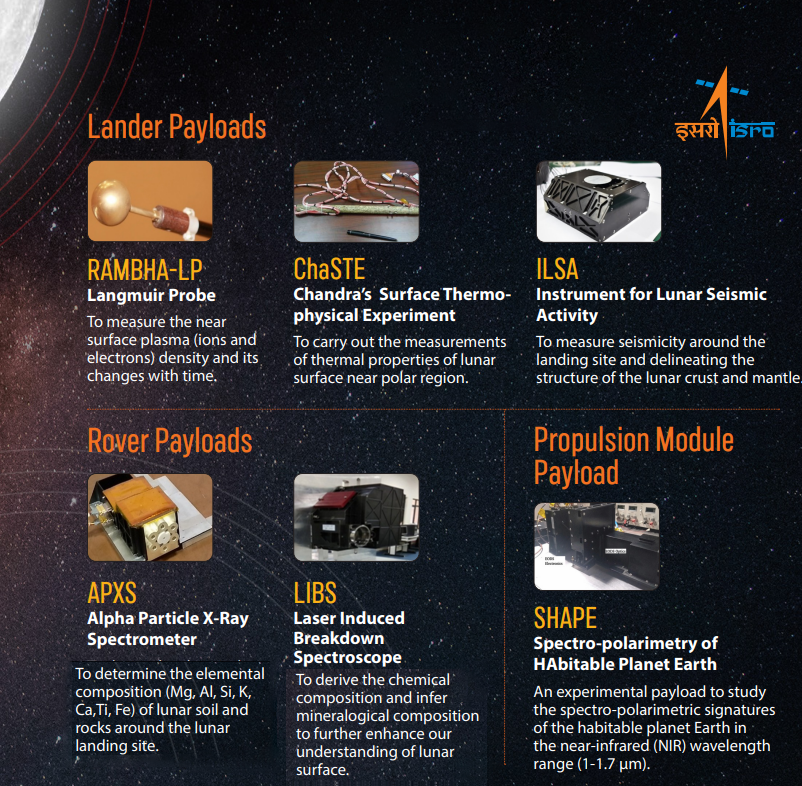Chandrayaan-3 Successfully Lands on Moon's South Pole | 24 Aug 2023
For Prelims: Chandrayaan-3, Vikram Lander and Pragyan Rover, Lunar Day, Spectro-polarimetry of Habitable Planet Earth (SHAPE), LUPEX, Aditya L1, NISAR, Gaganyaan, Shukrayaan 1, XPoSat.
For Mains: Objectives of Chandrayaan-3 Mission, Achievements of India in Space Sector.
Why in News?
Chandrayaan-3 has made history by becoming the first mission to soft-land on the lunar south pole, a region that has never been explored before. The mission aimed to demonstrate safe and soft lunar landing, rover mobility, and in-situ scientific experiments.
- India now joins the United States, Russia, and China as one of the few countries to successfully land on the Moon.
How did Chandrayaan-3 Prevail Over Obstacles Encountered in the Previous Mission?
- Chandrayaan-3's successful landing came after the setback of the Chandrayaan-2 mission's landing failure in 2019.
- The Vikram lander of Chandrayaan-2 had lost control and communication during descent, leading to a crash on the lunar surface.
- Lessons from the Chandrayaan-2 mission were applied to Chandrayaan-3, focusing on a "failure-based" design approach to anticipate and mitigate potential issues.
- Critical changes included strengthening the lander's legs, increasing fuel reserves, and enhancing landing site flexibility.
Why did Chandrayaan-3 Choose Moon's Near Side for Landing?
- Chandrayaan-3 aimed to investigate "permanently shadowed regions" near the South Pole for potential water-ice and resources.
- The Vikram lander's controlled descent achieved one of the closest approaches to the Moon's South Pole.
- While a notable achievement, Vikram's landing occurred on the Moon's near side, unlike China's Chang'e 4 on the far side.
- The near side, visible from Earth due to synchronous rotation, covers 60% of the Moon.
- The far side, though not always in darkness, remained hidden until the Soviet spacecraft Luna 3 captured images in 1959.
- Astronauts aboard the Apollo 8 mission in 1968 became the first humans to observe the far side directly.
- The near side boasts smoother surfaces and numerous 'maria' (large volcanic plains), while the far side features massive craters from asteroid impacts.
- The lunar crust on the near side is thinner, causing volcanic lava to flow and fill craters over time, creating flat terrains.
- The decision to land on the near side was driven by the mission's primary goal of a controlled soft landing.
- Landing on the far side would require a relay for communication due to the lack of direct line-of-sight with Earth.
What are the Intended Actions for Chandrayaan-3 after its Landing?
- Chandrayaan-3 is expected to operate for at least one lunar day (14 Earth days) on the lunar surface.
- The Pragyan rover will move around the landing site within a radius of 500 meters, conducting experiments and sending data and images to the lander.
- The Vikram lander will relay the data and images to the orbiter, which will then transmit them to Earth.
- Lander and Rover modules are collectively equipped with advanced scientific payloads.
- These instruments are designed to conduct comprehensive investigations into diverse facets of lunar characteristics, encompassing terrain analysis, mineralogical composition, surface chemistry, atmospheric attributes, and crucially, the exploration for water and potential resource reservoirs.
- The propulsion module that carried the lander and rover configuration till 100 km lunar orbit also has a Spectro-polarimetry of Habitable Planet Earth (SHAPE) payload to study the spectral and Polari metric measurements of Earth from the lunar orbit.
What are ISRO's Future Expeditions?
- Chandrayaan-4: Navigating the Path of Lunar Evolution
- Building upon past missions, Chandrayaan-4 emerges as a potential candidate for a sample return mission.
- If successful, it could mark the next logical step after Chandrayaan-2 and 3, offering the capability to retrieve lunar surface samples.
- The mission holds promise for advancing our understanding of the Moon's composition and history.
- Building upon past missions, Chandrayaan-4 emerges as a potential candidate for a sample return mission.
- LUPEX: Lunar Polar Exploration (LUPEX) mission, a collaborative effort between ISRO and JAXA(Japan), is poised to explore the Moon's polar regions.
- It will be specifically designed to venture into permanently shaded areas.
- Investigating the presence of water and assessing the potential for a sustainable long-term station are among LUPEX's objectives.
- Aditya-L1: Aditya L1 will be the first space based Indian mission to study the Sun.
- The spacecraft shall be placed in a halo orbit around the Lagrange point 1 (L1) of the Sun-Earth system, which is about 1.5 million km from the Earth.
- Observing the sun's corona, emissions, solar winds, flares, and coronal mass ejections are the primary focus areas of Aditya-L1.
- XPoSat (X-ray Polarimeter Satellite): It is India’s first dedicated polarimetry mission to study various dynamics of bright astronomical X-ray sources in extreme conditions.
- The spacecraft will carry two scientific payloads in a low earth orbit.
- NISAR: NASA-ISRO SAR (NISAR) is a Low Earth Orbit (LEO) observatory being jointly developed by NASA and ISRO.
- NISAR will map the entire globe in 12 days and provide spatially and temporally consistent data for understanding changes in Earth’s ecosystems, ice mass, vegetation biomass, sea level rise, ground water and natural hazards including earthquakes, tsunamis, volcanoes and landslides.
- Gaganyaan: Gaganyaan mission aims to send humans to space and return them safely to Earth. The mission will consist of two unmanned flights and one manned flight, using the GSLV Mk III launch vehicle and a human-rated orbital module.
- The manned flight will carry three astronauts, including a woman, for up to seven days in low Earth orbit.
- Shukrayaan 1: It is a planned mission to send an orbiter to Venus, the second planet from the Sun. It is expected to study Venus’s geological and volcanic activity, emissions on the ground, wind speed, cloud cover, and other planetary characteristics.
UPSC Civil Services Examination, Previous Year Question (PYQ)
Q. Discuss India’s achievements in the field of Space Science and Technology. How the application of this technology helped India in its socio-economic development? (2016)

